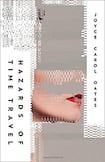
Can a character develop some degree of awareness – however dim – of the book it inhabits? This preposterous question wormed its way into my mind midway through Hazards of Time Travel, haunting me until the final page.
Joyce Carol Oates’s compendious new novel is set 20 years hence in a derivative dystopian world, replete with the habitual initialisms. The RNAS (Reconstituted North American States) is a one-party regime characterised by a rigid caste system based on 10 ST (Skin Tone) categories, permanent warfare conducted by proxy through “robot-missiles” and, of course, ubiquitous high-tech surveillance of the population. At school, where education is limited to the rote learning of undisputed facts – for example, the inferiority of the average female IQ – students “hold back” so as not to stand out by appearing too clever: “In a True Democracy all individuals are equal – no one is better than anyone else.”
Adriane Strohl, the 17-year-old narrator-protagonist, proves more equal than others and is made to suffer the consequences. Given that her scientist father was already an MI (Marked Individual) due to his association with an SI (Subversive Individual), his own brother, who was “deleted” by DDS (Domestic Drone Strike), although it later transpires, for no obvious reason, that the execution did not take place – she should perhaps have known better. This, however, is the whole point. We are made to understand, by the third sentence, and then relentlessly throughout the rest of the book, that free will is both her tragic flaw and the mark of her humanity. To think that Oates could have produced a haiku instead of a doorstop!
Before 9/11
For having the audacity to inquire what came “before the beginning of Time”, which in the RNAS refers to the “Great Terrorist Attacks of 9/11”, Adriane is charged with “Treason-Spech” and exiled in the past – a sentence that strangely provides an answer to the question for which she is punished. Her molecules are dissolved, teleported and reconstituted in 1959, before her parents were even born. She is now Mary Ellen Enright, a freshman at Wainscotia University in Wisconsin. As an EI (Exiled Individual) she is not allowed to stray beyond a 10-mile radius from her “epicentre”, or reveal her status to anyone, on threat of instant deletion. Worse still, she is exiled from exile: a microchip planted in her head blocks out memories of her past life, which appear like “shadowy shapes” viewed through a “frosted-glass window”. This raises one of the central questions in the novel – “What is a human being except the sum of her memories?” – and triggers an extended metaphor (the Nabokovian glass flowers; the “glassy eyes” of the stuffed animals in the gothic museum scene) that expresses the totalitarian quality of transparency.
Located in Zone 9, an area that does not appear on any map back in the RNAS, Wainscotia – aka the "Happy Place" – provides ample opportunity for Life on Mars-style culture shocks. Scratch the idyllic surface, and you discover a more sinister world of rampant anti-Semitism and misogyny. Pacifists are hounded out of campus, female students aspire to be Stepford Wives and the university is a "hotbed of mediocrity". The author, revisiting her own youth, evidently wants to show that the seeds of totalitarianism were sown in the 1950s, but Wainscotia seems so wholesome compared with NAS-23 that the strategy all but backfires.
Not machines
The moral (human beings are not machines and it is always now) is sophomoric. The narrator’s cloying diary style and intemperate deployment of exclamation marks becomes grating after a while. Soliloquies masquerade as dialogue. The fussy descriptions of minor characters seem to come straight out of a middlebrow potboiler circa 1959. Embarrassing repetitions should have been edited out.
For all its flaws, Oates's 46th novel is a page-turner, with cliffhanger chapter endings that may well have been written with Netflix in mind. Once Adriane and Ira Wolfman – the dashing psychology assistant professor with a fittingly Freudian name – have failed to flee, following a trail that loops back on itself (as in TV drama The Returned), the novelist loses her (Ariadne's) thread and the plot begins to unravel.
When the heroine laments her inability to suspend disbelief at the cinema – “The actors were so obviously acting. The film was so obviously a film” – or dismisses the unconvincing “realistic” paintings hanging in the Fine Arts Building, she almost seems to sense that her exile in Wainscotia is but a metaphor for being trapped in this novel.










